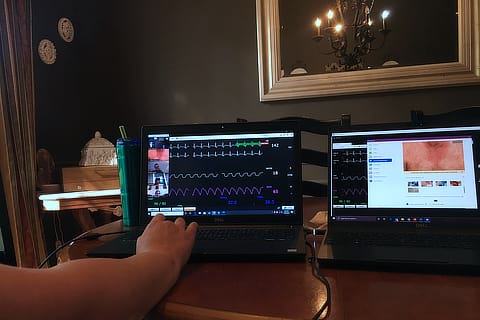
For Samford University’s College of Health Sciences, experiential training simulations are a core curriculum element for students learning everything from simple skills and tasks to strategies for managing complex health care scenarios. The college’s 22,000 sq. foot Experiential Learning and Simulation Center contains everything from clinical labs to a high-fidelity suite and affords students with the opportunity to participate in interprofessional activities and a variety of health care scenarios including - emergency, medical-surgical, intensive care and more. To continue the long-standing commitment to simulation education despite gathering limitations, the College of Health Sciences worked quickly to adapt training for a virtual setting.
This summer, Samford’s Experiential Learning and Simulation Center hosted a virtual simulation experience for Doctor of Physical Therapy students from Samford’s School of Health Professions and DeSales University in Center Valley, Pennsylvania. The event was the first telehealth simulation for both programs.
During the virtual simulation, physical therapy students from both universities utilized the Zoom collaboration platform to individually assess two standardized patients. Standardized patients are individuals who take on the characteristics of a real patient, affording students an opportunity to learn and be evaluated on learned skills in a simulated clinical environment. In total, 63 students participated in the simulation event – 35 Samford students and 28 from DeSales University. In addition to technical training, the event offered a unique interprofessional opportunity.
“This simulation was unique because it afforded students an opportunity to collaborate, discuss and explore similarities and differences in what students are learning across different institutions,” said Jill Pence, associate professor and Experiential Learning and Simulation Center executive director for Samford University.
Pence’s inspiration for developing the simulation experience came from seeing the need to fill a void in opportunities. Following implementation of remote learning in March, Pence says she began researching virtual simulation options for students and faculty. While she found an abundance of options for medicine and nursing, the other health professions, which she says are newer to simulation, had limited options. In an effort to find an option for Doctor of Physical Therapy students, Pence sought an online community of simulation directors and specialists. She connected with the simulation director at DeSales University and the virtual simulation preparation began.
Virtual experiences are also providing new exposure to telehealth communication. Students in the Ida Moffett School of Nursing and School of Public Health completed the Opioid Workforce Expansion Program’s first interprofessional virtual simulation. During the exercise, students from the college’s social work and psychiatric mental nurse practitioner disciplines, worked together utilizing learned skills to assess standardized patients which they could see and interact with virtually.
Stephanie Wynn, professor for Ida Moffett School of Nursing and grant manager, explained that while a virtual simulation was not part of the original grant curriculum, the skills gained through this learning activity, especially telehealth communication, have proven to be necessary during the pandemic.
“In the wake of the COVID-19 pandemic, providers around the world are utilizing telehealth to provide patient care. The use of health technology to assess patients virtually is a reality that many providers are facing for the first time,” said Wynn. “Moving forward, I believe we will continue to face new realities in health care. This virtual simulation has further prepared our students to serve as behavioral health professionals regardless of the location, scenario or means.”
Many plan to take the learnings from virtual simulation and continue developing more in-depth exercises in the future. Students in the nurse anesthesia program recently completed a training on rare, but life-threatening anesthesia conditions using Zoom to view still images and discuss procedure techniques.
“The students were able to focus on addressing the crisis at hand and had to talk through the steps of the skills they would perform and the medications they would administer,” adjunct professor Mary Beth Greenway said. “We got great feedback from our students and are planning to utilize the existing technology we have to create more high-fidelity virtual simulations in the future.”